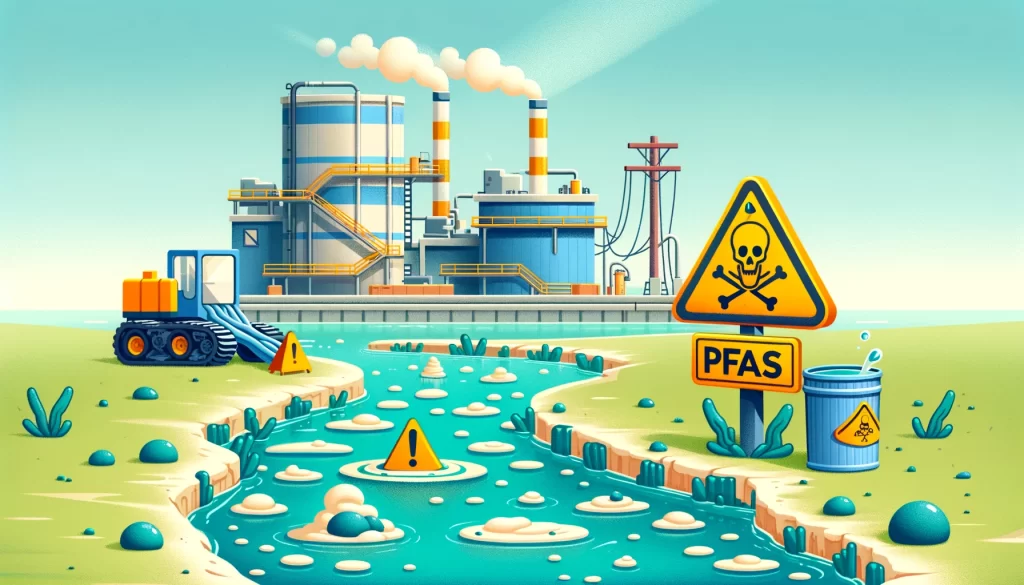Lawyers have warned that upcoming lawsuits regarding PFAS chemicals could surpass the costs seen in asbestos litigation. Brian Gross, a defense lawyer, addressed plastic-industry executives at a recent conference, predicting “astronomical” costs from these lawsuits. He stated that the coming litigation could “dwarf anything related to asbestos,” which has been one of the most significant corporate-liability battles in U.S. history.
Understanding PFAS
PFAS, or per- and polyfluoroalkyl substances, are a group of nearly 15,000 synthetic chemicals used in numerous everyday products. These include cosmetics, takeout containers, frying pans, and firefighting foams. Due to their resistance to water, stains, heat, and grease, PFAS have been widely used since their invention by DuPont chemists in the 1940s. However, these same properties make PFAS extremely persistent in the environment, earning them the nickname “forever chemicals.”
Scientists have found PFAS almost everywhere, from drinking water to rain over the Great Lakes, and even in Antarctic snow. They have also been detected in the blood of nearly every American. Research links PFAS exposure to serious health issues such as testicular and kidney cancers, developmental delays in children, decreased fertility, liver damage, and thyroid disease. The chemicals are so long-lasting that scientists have yet to determine how long they might take to break down completely.
Government Intervention
In response to these concerns, the federal government has taken steps to regulate PFAS. Recently, the government announced that several types of PFAS must be removed from the drinking water of hundreds of millions of Americans. Additionally, the Environmental Protection Agency (EPA) has designated two types of PFAS as hazardous substances under the Superfund law, which will shift the responsibility for cleanup from taxpayers to polluters.

Ongoing and Future Legal Battles
The legal landscape surrounding PFAS is rapidly evolving. Companies like DuPont, its spinoff Chemours, and 3M have already faced numerous lawsuits. Last year, 3M agreed to pay at least $10 billion to water utilities across the United States for cleanup costs. Thirty state attorneys general have also sued PFAS manufacturers for widespread contamination. Experts, however, believe that the legal battles are just beginning.
A broader range of companies that use PFAS in their products is coming under scrutiny. For instance, a class-action lawsuit was recently filed against Bic for failing to disclose that some of its razors contained PFAS. While Bic has not commented on the pending litigation, it has reiterated its commitment to safety.
Industry and Legal Community Response
In preparation for the surge in litigation, the plastic and chemical industries are reviewing their communications and defenses. Mr. Gross advised companies to review their marketing materials and other communications with customers and suppliers to identify any potentially problematic documents. He also suggested finding the right witnesses to represent their companies.
Emily M. Lamond, an environmental litigation attorney, emphasized the magnitude of the upcoming legal challenges. She compared the potential PFAS-related litigation to past legal battles involving tobacco, asbestos, and methyl tert-butyl ether (MTBE), a harmful gasoline additive. “To say that the floodgates are opening is an understatement,” she said.

Personal Impact and Cases
Individuals affected by PFAS exposure have already begun seeking justice. Sandy Wynn-Stelt of Belmont, Michigan, brought an early case after discovering that PFAS-laden tannery waste had been dumped near her home. She lost her husband to liver cancer in 2016 and was later diagnosed with thyroid cancer. She sued Wolverine and 3M, reaching a settlement in 2021. Nearly 2,000 local residents also settled a class-action lawsuit against Wolverine. However, the region’s water source remains polluted with PFAS.
Scientific and Research Challenges
The vast number of PFAS chemicals, each with slightly different health effects, poses a significant challenge to research and litigation. Scientists must conduct long-term studies to assess the health impacts, which can take a long time to manifest. Dr. Steph Tai, an expert in environmental protection and litigation, explained that researchers often have to rely on “natural experiments” by comparing populations with different levels of exposure.
The industry has seen some legal victories. Last November, the United States Court of Appeals for the Sixth Circuit dismissed a major lawsuit over PFAS exposure, ruling that the plaintiff could not prove the PFAS in his blood came from the companies he sued. Despite these victories, the legal and environmental challenges continue.
Industry Adjustments and Future Steps
In response to growing scrutiny, companies like 3M have begun phasing out certain PFAS chemicals. 3M plans to stop using PFAS chemicals by the end of next year, contingent on finding substitutes. The Biden administration’s infrastructure law provides $9 billion to help communities address PFAS contamination, with $1 billion set aside for initial testing and treatment.
This article is based on the following article:

Background Information
What are PFAS?
PFAS stands for per- and polyfluoroalkyl substances, which are a large group of human-made chemicals used since the 1940s. They are valued for their resistance to heat, water, and grease, making them useful in various industrial applications and consumer products. PFAS include chemicals like PFOA (perfluorooctanoic acid) and PFOS (perfluorooctanesulfonic acid).
Uses of PFAS
PFAS have been used in:
- Nonstick cookware (like Teflon)
- Water-repellent clothing and fabrics (like Scotchgard)
- Food packaging (like microwave popcorn bags)
- Firefighting foams
- Personal care products (like shampoos and cosmetics)
Environmental Impact
The durability of PFAS means they do not break down easily in the environment, earning them the nickname “forever chemicals.” They can accumulate in water, soil, air, and living organisms, including humans.
Health Concerns
Exposure to PFAS has been linked to various health problems:
- Cancer (testicular, kidney, and possibly others)
- Developmental delays in children
- Decreased fertility
- Liver damage
- Thyroid disease
PFAS can enter the human body through contaminated food, water, and air. Nearly every American is believed to have some level of PFAS in their blood.
Historical Context
Asbestos Litigation:
- Asbestos was once widely used in construction materials for its fire-resistant properties.
- Inhalation of asbestos fibers can cause serious diseases, including lung cancer and mesothelioma.
- Massive litigation ensued as people who were exposed to asbestos sought compensation for their health problems.
Tobacco Litigation:
- Tobacco companies faced numerous lawsuits for not disclosing the harmful effects of smoking.
- These lawsuits resulted in significant settlements and changes in tobacco advertising and sales.
MTBE Litigation:
- Methyl tert-butyl ether (MTBE) was a gasoline additive used to improve air quality.
- MTBE contaminated drinking water supplies, leading to health concerns and subsequent litigation.
Government and Regulatory Actions
The Environmental Protection Agency (EPA) is a U.S. federal agency responsible for protecting human health and the environment. It has taken several steps to regulate PFAS:
- Designating certain PFAS chemicals as hazardous substances.
- Requiring municipal water systems to remove specific types of PFAS from drinking water.
Superfund Law:
- The Comprehensive Environmental Response, Compensation, and Liability Act (CERCLA), commonly known as the Superfund law, aims to clean up contaminated sites.
- The designation of PFAS as hazardous under this law means that companies responsible for pollution are liable for cleanup costs.
Recent Legal Developments
Many companies, including major manufacturers like DuPont and 3M, have faced lawsuits for PFAS contamination. Settlements and legal battles have resulted in billions of dollars being allocated for cleanup and compensation.
Industry Response
Companies are reviewing their practices and preparing for increased litigation. Some have begun phasing out certain PFAS chemicals and seeking safer alternatives.
Scientific Research and Challenges
Research on PFAS is ongoing, with scientists working to understand the full extent of their health impacts. The wide variety of PFAS chemicals and the long time it takes for health effects to become apparent make this research complex and challenging.
Please subscribe to Insight Fortnight, our biweekly newsletter!
